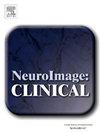非典型抑郁症和非典型抑郁症中与威胁相关逆境相关的轴突丧失的不同模式
IF 3.6
2区 医学
Q2 NEUROIMAGING
引用次数: 0
摘要
背景:重度抑郁障碍(MDD)包括由不同病因机制引起的广泛异质性症状。精神病理学的表型标记最有可能受到童年虐待的影响,在传统的诊断界限内产生不同的亚型。然而,重度抑郁症亚型和儿童创伤类型之间的生物学相互作用尚不清楚。方法选取50例非典型抑郁症(AD)患者、97例非AD患者和50例健康对照者进行MRI多壳扩散扫描和临床评价。采用微分束造影来明确AD组和非AD组之间的轴突损伤。此外,应用相关神经束造影单独评估各抑郁亚组定量各向异性(QA)与所有类型儿童创伤的关系。结果阿尔茨海默病患者和非阿尔茨海默病患者存在不同的轴突损失,主要涉及双侧上纵束、弓形束、下纵束、顶叶斜束和胼胝体。此外,AD患者的QA值、童年创伤总分和威胁相关逆境之间存在显著负相关,而非AD患者的QA值与威胁相关逆境之间存在显著正相关。然而,在与剥夺相关的逆境中没有观察到类似的现象。我们的研究结果表明,在非典型抑郁症和非典型抑郁症中,与威胁相关逆境相关的轴突改变的空间模式存在差异。减轻童年虐待对重度抑郁症的影响的努力应该考虑到特定的逆境模式和特定的临床表现之间的联系。本文章由计算机程序翻译,如有差异,请以英文原文为准。
Differential patterns of axonal loss associated with threat-related adversity in atypical depression and non-atypical depression
Background
Major depressive disorder (MDD) encompasses a broad spectrum of heterogeneous symptoms arising from distinct etiological mechanisms. Phenotypic markers of psychopathology are most likely influenced by exposure to childhood maltreatment, yielding distinct subtypes within conventional diagnostic boundaries. However, the biological interactions between MDD subtypes and types of childhood trauma remain unclear.
Methods
50 atypical depression (AD) patients, 97 non-AD patients and 50 healthy controls were included to complete multi-shell diffusion MRI scans and clinical assessments. Differential tractography was performed to clarify the axonal injury between the AD and non-AD groups. Moreover, correlational tractography was employed to individually assess the relationship between quantitative anisotropy (QA) and all types of childhood trauma in each depressed subgroup.
Results
Our study found that AD and non-AD patients had differential axonal loss primarily involving the bilateral superior longitudinal fasciculus, arcuate fasciculus, inferior longitudinal fasciculus, parietal aslant tract, and corpus callosum. Furthermore, AD patients showed significantly negative associations between QA values, childhood trauma total scores, and threat-related adversity, while significantly positive associations were observed in non-AD patients. However, similar phenomena were not observed for deprivation-related adversities.
Discussion
Our findings indicate differential spatial patterns of axonal alterations associated with threat-related adversity in atypical depression and non-atypical depression. Efforts to attenuate the consequences of childhood maltreatment for MDD should consider the associations between specific patterns of adversity and specific clinical manifestations.
求助全文
通过发布文献求助,成功后即可免费获取论文全文。
去求助
来源期刊

Neuroimage-Clinical
NEUROIMAGING-
CiteScore
7.50
自引率
4.80%
发文量
368
审稿时长
52 days
期刊介绍:
NeuroImage: Clinical, a journal of diseases, disorders and syndromes involving the Nervous System, provides a vehicle for communicating important advances in the study of abnormal structure-function relationships of the human nervous system based on imaging.
The focus of NeuroImage: Clinical is on defining changes to the brain associated with primary neurologic and psychiatric diseases and disorders of the nervous system as well as behavioral syndromes and developmental conditions. The main criterion for judging papers is the extent of scientific advancement in the understanding of the pathophysiologic mechanisms of diseases and disorders, in identification of functional models that link clinical signs and symptoms with brain function and in the creation of image based tools applicable to a broad range of clinical needs including diagnosis, monitoring and tracking of illness, predicting therapeutic response and development of new treatments. Papers dealing with structure and function in animal models will also be considered if they reveal mechanisms that can be readily translated to human conditions.
 求助内容:
求助内容: 应助结果提醒方式:
应助结果提醒方式:


